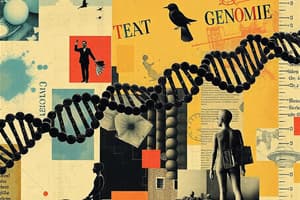Podcast
Questions and Answers
What is the primary challenge associated with the pure shotgun sequencing method?
What is the primary challenge associated with the pure shotgun sequencing method?
- Identification of tandem and genome-wide repeated sequences (correct)
- Dependence on clone libraries for effective sequencing
- Requirement for extensive genomic mapping prior to sequencing
- Difficulty in assembling contigs from small sequences
Which method of sequencing utilizes a traditional step-wise approach with genomic mapping?
Which method of sequencing utilizes a traditional step-wise approach with genomic mapping?
- Whole Genome Sequencing
- Clone Contig Method (correct)
- Shotgun Sequencing
- Canonical Sequencing
What advantage does shotgun sequencing have over the clone-contig method?
What advantage does shotgun sequencing have over the clone-contig method?
- It provides a more accurate genomic map.
- It is cheaper and requires fewer resources.
- It completely avoids the problem of overlaps.
- It can process larger amounts of data quickly. (correct)
Which factor is crucial for both clone-contig and shotgun sequencing approaches?
Which factor is crucial for both clone-contig and shotgun sequencing approaches?
What is required for entire clones to be sequenced effectively?
What is required for entire clones to be sequenced effectively?
What is a genome primarily composed of?
What is a genome primarily composed of?
What is the initial step in creating a genomic library?
What is the initial step in creating a genomic library?
What does the term 'clone-contig' refer to in genome sequencing?
What does the term 'clone-contig' refer to in genome sequencing?
Why are genomic maps important in genome sequencing?
Why are genomic maps important in genome sequencing?
What is the maximum amount of information produced in a single run by state-of-the-art sequencing technology?
What is the maximum amount of information produced in a single run by state-of-the-art sequencing technology?
What sequencing method requires a fragment overlap to ensure a single occurrence in the human genome?
What sequencing method requires a fragment overlap to ensure a single occurrence in the human genome?
What is one of the two forces driving evolution as mentioned in the context of genome stability?
What is one of the two forces driving evolution as mentioned in the context of genome stability?
What does 'shotgun sequencing' specifically refer to?
What does 'shotgun sequencing' specifically refer to?
Study Notes
Understanding Genomes
- A genome is the complete nucleic acid sequence that encodes the organism's hereditary information and genetic material passed to offspring.
- Functional units called genes are arranged linearly on chromosomes within the genome.
- Genome sequences are typically stable but can undergo replication errors and mutations, driving evolutionary change alongside natural selection.
Advances in Genomic Sequencing
- Recent advances in sequencing technology have dramatically increased the number of decoded whole genomes.
- Human genomes consist of approximately 3.2 billion bases.
- Current state-of-the-art sequencing can provide up to 750 bases of sequence information in a single run, requiring around 4.3 million runs to decode a human genome (3.2 billion ÷ 750).
Genomic Mapping
- Genomic maps serve as crucial aids in sequencing by providing markers that help navigate through the large and complex genomes.
- The concept of image stitching is analogous to genomic mapping; genomic maps help assemble contigs from overlapping sequences.
Genomic Libraries
- Genomic libraries are created by cloning DNA fragments into bacterial or yeast hosts, allowing for replication and sequencing of these fragments.
- Cloning techniques can involve either traditional methods or cell-free approaches like Polymerase Chain Reaction (PCR).
Sequencing Strategies
- Two main sequencing approaches are employed: Clone Contig and Shotgun sequencing.
- Clone Contig: An older, systematic method that sequences individual clones based on their position on a genomic map.
- Shotgun Sequencing: A newer approach that utilizes computational methods to identify overlaps in randomly sequenced fragments, assembling them into contigs on a genomic map.
Challenges in Sequencing
- The primary challenge in shotgun sequencing is accurately managing tandemly repeated and genome-wide repeated sequences, which can complicate the assembly of the genomic data.
Importance of Genomic Maps
- Genomic map features are vital for both sequencing methodologies as they assist in organizing the data and ensuring accurate assembly of sequences.
- Helpful map features for sequencing include markers that indicate clone origins, overlap regions, and other sequence identifiers that guide assembly efforts.
Studying That Suits You
Use AI to generate personalized quizzes and flashcards to suit your learning preferences.
Description
This quiz focuses on the strategies used for sequencing genomes as outlined in Module 2.1. It covers fundamental concepts such as genomic libraries, clone-contig, and shotgun sequencing approaches. Participants will enhance their understanding of genomic maps and their importance in genome decoding.




